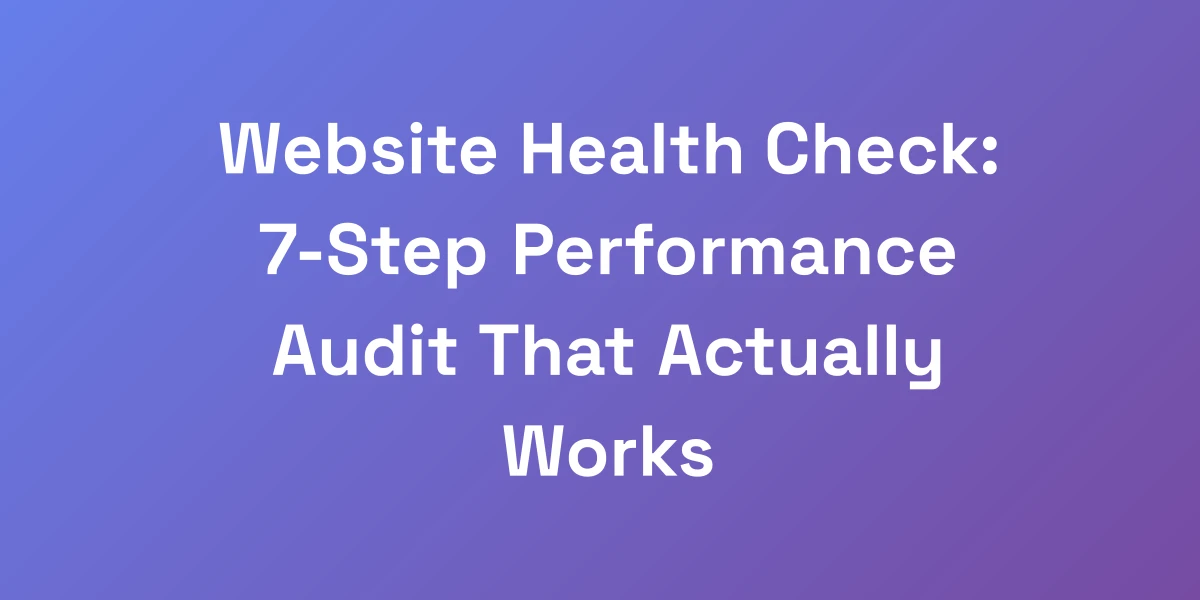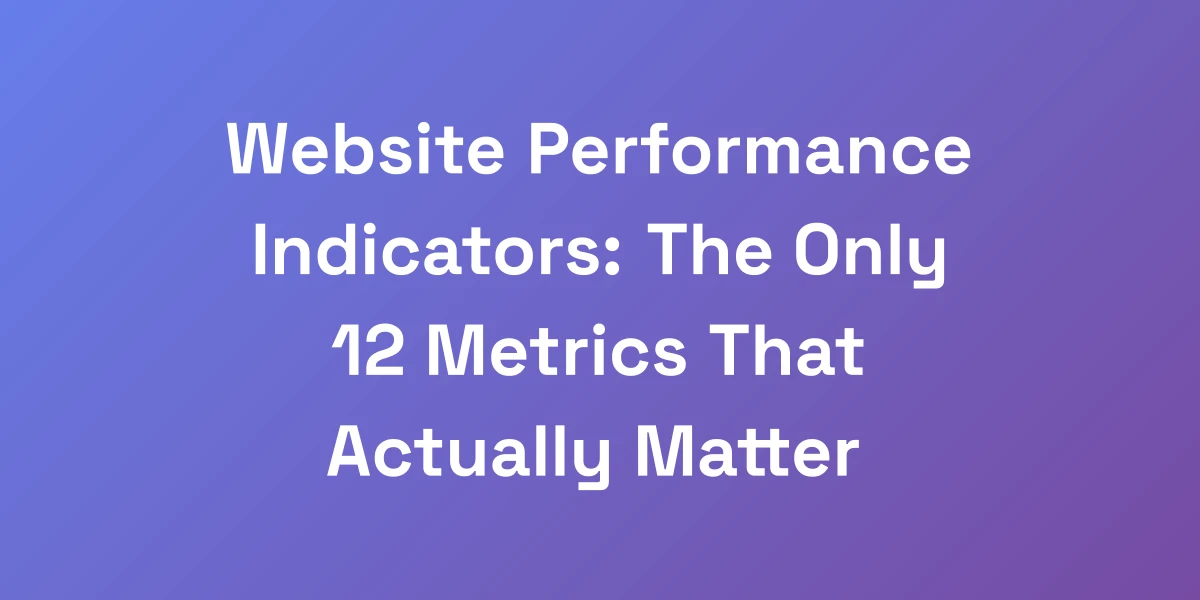
Website Health Check: 7-Step Performance Audit That Actually Works
Mar 16, 2025 | By [email protected]
Introduction
Let’s get real – the majority of website health checks out there are pure nonsense. They spit out generic scores that don’t mean a damn thing. We’re tired of the fluff and the jargon that leaves you with nothing actionable.
Imagine pouring thousands into your website, thinking you’re on the right track, only to watch your conversions stagnate. It’s frustrating, right?
Here’s the kicker: a genuine website health check digs deep into the critical performance factors that actually drive your business forward. No surface-level noise, just the hard-hitting analysis that transforms your website from mediocre to unstoppable.
In this guide, we’re cutting through the BS and laying out a 7-step performance audit that works. We’ve spent millions optimizing websites, and now we’re sharing the exact process that delivers real, measurable results. Ready to elevate your website’s performance? Let’s dive in.
Why Most Website Health Checks Fail (And What Actually Works)
Let’s cut to the chase – most website health checks are ineffective because they skim the surface. They rely on basic tools that provide superficial scores without digging into what truly matters. So why do they fail? Because they lack proper SEO website analytics, which are essential for understanding and improving your site’s true performance.
The Real Cost of Poor Website Health
Bad website health isn’t just an annoyance; it’s a direct drain on your revenue. A poorly performing site can lead to increased bounce rates, dropping conversion rates, and ultimately, lost sales.
Consider this: a mere 0.1-second improvement in load time can boost your pages viewed by up to 8.6%. We’re talking about tangible gains that translate directly to your bottom line.
Businesses that ignore their website’s health risk falling behind. One of our clients saw a 17% decrease in cost-per-click and a 31% decrease in cost-per-acquisition by addressing their website issues head-on. Check out our SEO case studies to see how we did it.
Common Website Health Check Myths Debunked
There are several misconceptions floating around about what constitutes an effective website health check. Let’s bust a few.
- Myth 1: A high score on basic tools means your site is healthy.
- Reality: Scores can be misleading. It’s about the underlying performance factors that truly impact user experience and conversions.
- Myth 2: Technical SEO is just about meta tags.
- Reality: Technical SEO is a comprehensive system that includes crawlability, schema markup, and internal linking architecture.
- Myth 3: Security is a one-time setup.
- Reality: Security is an ongoing process that adapts to new threats and protects your digital assets continuously.
The 7-Step Framework Overview
Our 7-step framework is designed to provide a thorough and actionable audit. Each step targets a critical area that can significantly impact your website’s performance and profitability.
- Core Web Vitals
- Technical SEO Health
- Security and SSL Health Analysis
- User Experience (UX) Health Metrics
- Content Performance Analysis
- Implementation and Monitoring Plan
- Continuous Optimization
Required Tools and Resources
To execute our audit effectively, you’ll need a set of robust tools. These include:
- Google PageSpeed Insights: For analyzing load times and performance metrics.
- Lighthouse: To get comprehensive insights into various aspects of your site’s health.
- GTmetrix: For detailed performance reports and optimization suggestions.
- Google Search Console: Essential for monitoring crawl errors and indexing issues.
- Security Scanners: Tools like Sucuri or Malwarebytes to check for vulnerabilities.
Setting Baseline Metrics
Before you can measure improvement, you need to understand where you stand. Establishing baseline metrics is essential.
- Load Time: Measure your current page load speed.
- Conversion Rates: Document your existing conversion statistics.
- Bounce Rates: Identify current bounce rates across key pages.
- Core Web Vitals Scores: Record your current LCP, FID, and CLS scores.
These baseline metrics will serve as your reference points, allowing you to track progress and measure the impact of your optimizations.
Core Web Vitals: The Foundation of Website Performance
Listen up – if you’re not obsessing over Core Web Vitals, you’re leaving money on the table. These metrics aren’t just some Google buzzwords; they’re direct indicators of how many visitors you’re losing to poor performance.
We’ve seen businesses double their conversion rates just by optimizing these three key metrics. The best part? Most of your competitors are completely ignoring them. Let me show you how to leverage this opportunity and crush your competition.
Understanding LCP (Largest Contentful Paint)
Largest Contentful Paint measures how long it takes for the main content of your page to load. A good LCP score is under 2.5 seconds. If your LCP is slow, users are likely to abandon your site before it fully loads.
- Optimize images by compressing them without losing quality.
- Improve server response times by leveraging a Content Delivery Network (CDN).
- Minimize CSS and JavaScript to reduce rendering time.
Mastering FID (First Input Delay)
First Input Delay measures the time from when a user first interacts with your site to the time the browser responds. An FID under 100ms is ideal. High FID can frustrate users, leading to drop-offs.
- Break up long JavaScript tasks to ensure the main thread is not blocked.
- Use web workers to handle heavy computations in the background.
- Streamline your code to reduce the time taken to process user interactions.
Optimizing CLS (Cumulative Layout Shift)
Cumulative Layout Shift tracks visual stability by measuring unexpected layout shifts. Keep your CLS below 0.1 to ensure a smooth user experience.
- Always include size attributes for images and videos to prevent layout shifts.
- Avoid inserting content above existing content, except in response to user interactions.
- Use CSS transforms for animations instead of adding new DOM elements.
Mobile vs Desktop Performance Gaps
With over 58% of global internet traffic coming from mobile devices, optimizing for mobile is non-negotiable. The US sees slightly more desktop traffic, but mobile is rapidly catching up.
- Ensure your site is fully responsive and adapts seamlessly to different screen sizes.
- Optimize touch interactions to reduce delays in mobile responsiveness.
- Prioritize mobile loading speeds to keep your mobile users engaged.
Quick Wins for Immediate Impact
Sometimes, small changes can lead to significant improvements. Here are some quick wins to enhance your Core Web Vitals:
- Compress and optimize images using modern formats like WebP.
- Enable browser caching to reduce load times for repeat visitors.
- Remove unnecessary third-party scripts that slow down your site.
- Implement lazy loading for offscreen images to improve initial load times.
Technical SEO Health: Beyond Basic Optimization
Your technical SEO isn’t just about meta tags anymore. In today’s digital landscape, it’s about creating a robust technical foundation that Google can’t ignore.
We’ve helped companies go from zero to millions in revenue by fixing technical SEO issues that their so-called “black hat SEO” experts missed. The secret? Understanding that technical SEO is a system, not a checklist. Here’s how to build that system and dominate your market.
Advanced Crawlability Assessment
Ensure that search engines can efficiently crawl and index your website. Use robots.txt wisely to manage crawl access and submit a comprehensive sitemap.
- Regularly monitor crawl errors in Google Search Console.
- Eliminate duplicate content issues that can confuse search engines.
- Ensure that important pages are easily accessible from your homepage.
Schema Markup Optimization
Structured data helps search engines understand your content better, enhancing your visibility in search results. Implementing schema markup can lead to rich snippets, boosting your CTR.
- Use JSON-LD format for adding structured data to your pages.
- Focus on relevant schema types like Product, Article, and Review.
- Validate your schema markup using Google’s Structured Data Testing Tool.
Internal Linking Architecture
A well-structured internal linking system ensures that authority flows smoothly throughout your site, enhancing SEO and user navigation through smart linking.
- Create logical hierarchies with main and subcategories.
- Use descriptive anchor texts for your internal links.
- Ensure every important page is linked from at least one other relevant page.
Page Speed Optimization
Page speed is a critical ranking factor and a significant user experience element. Faster pages lead to better engagement and higher conversion rates.
- Minimize HTTP requests by combining files where possible.
- Use asynchronous loading for JavaScript to prevent render-blocking.
- Implement a Content Delivery Network (CDN) to serve content faster to global users. For predictions and strategies, refer to web performance optimization predictions.
Mobile-First Index Compliance
With Google’s mobile-first indexing, it’s essential that your mobile site is as robust as your desktop version. This means ensuring all content is accessible and functional on mobile devices.
- Ensure that mobile pages have the same content as desktop pages.
- Optimize images and other media for mobile viewing.
- Implement responsive design principles to provide a consistent user experience across mobile vs desktop devices.
Security and SSL Health Analysis
Here’s something most “experts” won’t tell you: Security isn’t just about having an SSL certificate. It’s about creating an impenetrable fortress for your digital assets.
We’ve witnessed businesses lose millions because they thought basic security was enough. The truth? Website security is a revenue generator, not a cost center. Let me show you how to turn your security measures into a competitive advantage.
SSL Configuration Assessment
Ensuring your SSL configuration is flawless is fundamental. An improper SSL setup can lead to security vulnerabilities and loss of user trust.
- Verify that all pages are served over HTTPS.
- Ensure certificates are up to date and correctly installed.
- Implement HTTP Strict Transport Security (HSTS) to enforce secure connections.
Security Headers Implementation
Security headers add an extra layer of protection against common vulnerabilities like cross-site scripting and clickjacking.
- Implement Content Security Policy (CSP) to control resources the browser is allowed to load.
- Use X-Frame-Options to protect against clickjacking.
- Set X-Content-Type-Options to prevent MIME type sniffing.
Malware and Vulnerability Scanning
Regularly scanning for malware and vulnerabilities is crucial to maintaining a secure website. Automated tools can help detect and mitigate threats before they wreak havoc.
- Conduct scheduled scans using tools like Sucuri or Malwarebytes.
- Monitor for unusual activity that could indicate a breach.
- Promptly address any vulnerabilities identified during scans.
Backup System Verification
Having a reliable backup system ensures that you can quickly recover from any security incidents without significant downtime or data loss.
- Implement automated daily backups to a secure location.
- Regularly test backups to ensure data integrity.
- Establish a clear backup restoration process to minimize recovery time.
Access Control Protocols
Managing who has access to your website’s backend is essential for maintaining security. Proper access controls prevent unauthorized changes and data breaches.
- Use strong, unique passwords and enable multi-factor authentication (MFA).
- Limit access permissions based on roles to minimize risk.
- Regularly review and update access privileges to ensure they are current and appropriate.
User Experience (UX) Health Metrics
Stop obsessing over pretty designs and start focusing on what actually drives conversions. We’ve tested thousands of websites, and here’s what we know: UX isn’t about looking good – it’s about making money. Check out how UX designs impact conversion rates.
The right UX changes can increase your conversion rates by 300% or more. Let’s dive into the exact metrics that matter and how to optimize them for maximum revenue impact.
Navigation Flow Analysis
Effective navigation ensures that users can find what they’re looking for without frustration. Poor navigation can lead to high bounce rates and lost sales.
- Map out user journeys to identify common paths and drop-off points.
- Simplify your menu structure to make navigation intuitive.
- Implement clear calls-to-action (CTAs) to guide users towards conversions.
Content Accessibility Scoring
Accessible content ensures that all users, regardless of disabilities, can interact with your website effectively. This not only broadens your audience but also improves SEO.
- Use semantic HTML to improve screen reader compatibility.
- Ensure sufficient color contrast for readability.
- Provide alternative text for all images and multimedia content.
Mobile Responsiveness Testing
With the majority of traffic coming from mobile devices, ensuring your site is fully responsive is crucial. A non-responsive site can alienate a large portion of your audience.
- Test your site on various devices and screen sizes to ensure consistency.
- Optimize touch targets for ease of use on mobile devices.
- Ensure that mobile navigation is as seamless as desktop navigation.
Form Optimization Checks
Forms are often the gateway to conversions, but poorly designed forms can deter users from completing them.
- Minimize the number of fields to reduce user effort.
- Use inline validation to provide immediate feedback.
- Ensure forms are mobile-friendly and easy to navigate.
Site Search Functionality
A robust site search function can significantly enhance user experience by helping visitors find exactly what they need quickly.
- Implement autocomplete features to guide user searches.
- Ensure search results are relevant and well-organized.
- Analyze search queries to understand user intent and tailor content accordingly.
Content Performance Analysis
Content isn’t king – converting content is king. We’ve seen businesses waste thousands on content that looks good but generates zero returns. The key? Understanding that content health isn’t about word count or keyword density – it’s about creating content that drives action.
Here’s our proven system for auditing and optimizing content that actually converts.
Content Gap Analysis
Identify the gaps in your current content strategy to ensure you’re meeting your audience’s needs and staying ahead of the competition.
- Analyze competitor content to find opportunities you might have missed using marketing intelligence.
- Survey your audience to understand what information they’re seeking.
- Fill in content gaps with targeted, high-value posts that address specific pain points.
Conversion Path Mapping
Understanding how users move through your site towards conversion points is essential for optimizing your content strategy.
- Map out the typical user journey from entry to conversion.
- Identify and eliminate any friction points that hinder progress.
- Enhance content at each step to guide users smoothly towards conversion.
Readability Scoring
Content that’s easy to read keeps users engaged longer, which can lead to higher conversion rates.
- Use tools like Hemingway or Grammarly to assess your content’s readability.
- Implement clear, concise language that is accessible to a wide audience.
- Break up text with headers, bullet points, and images to enhance readability.
Multimedia Performance
Integrating multimedia elements effectively can boost engagement and drive conversions.
- Ensure all multimedia content is optimized for fast loading times.
- Use videos and infographics to explain complex concepts more effectively.
- Monitor user interaction with multimedia elements to refine your strategy.
Content Update Strategy
Regularly updating your content ensures that your website remains relevant and continues to attract and convert visitors.
- Schedule periodic reviews of existing content to keep it fresh and accurate.
- Update outdated information and incorporate the latest industry trends.
- Repurpose high-performing content into other formats to reach a broader audience.
Implementation and Monitoring Plan
Having a great audit means nothing without proper implementation. We’ve seen countless businesses fail because they couldn’t turn insights into action. Here’s the truth: You need a systematic approach to implementing changes and monitoring results. Let’s break down our exact framework for turning your website health check into measurable business results.
Priority Action Items
Start by addressing the most critical issues that have the highest impact on performance and conversions.
- Fix any technical SEO problems that are currently hurting your search rankings.
- Optimize Core Web Vitals to improve load times and user experience.
- Implement security enhancements to protect your site and build user trust.
Implementation Timeline
Establishing a realistic timeline ensures that your optimization efforts are organized and effective.
- Plan phases: Prioritize tasks based on impact and complexity.
- Set deadlines: Allocate specific time frames for each optimization step.
- Monitor progress: Regularly check the status of each task to stay on track.
Progress Tracking Metrics
To measure the success of your optimizations, track key performance indicators (KPIs) that align with your business goals.
- Monitor changes in Core Web Vitals scores.
- Track improvements in conversion rates and reduce bounce rates.
- Analyze shifts in organic traffic and search engine rankings using SEO website analytics.
Maintenance Schedule
Website optimization is not a one-time task. Establish a maintenance schedule to ensure your site remains in top shape.
- Conduct regular performance audits every quarter.
- Update content and technical elements to adapt to new trends and algorithms.
- Continuously monitor security protocols to safeguard against emerging threats.
ROI Measurement Framework
Understanding the return on investment (ROI) of your website optimizations is crucial for justifying efforts and allocating resources effectively.
- Calculate the increase in revenue directly attributable to website improvements.
- Assess cost savings from reduced bounce rates and improved conversion rates.
- Use analytics to correlate specific changes with performance gains.








![Technical SEO Services That 10X Your Website’s Performance [2025]](https://autoseo.eazyseo.co/wp-content/uploads/2025/02/Technical-SEO-Services-That-10X-Your-Websites-Per.webp)